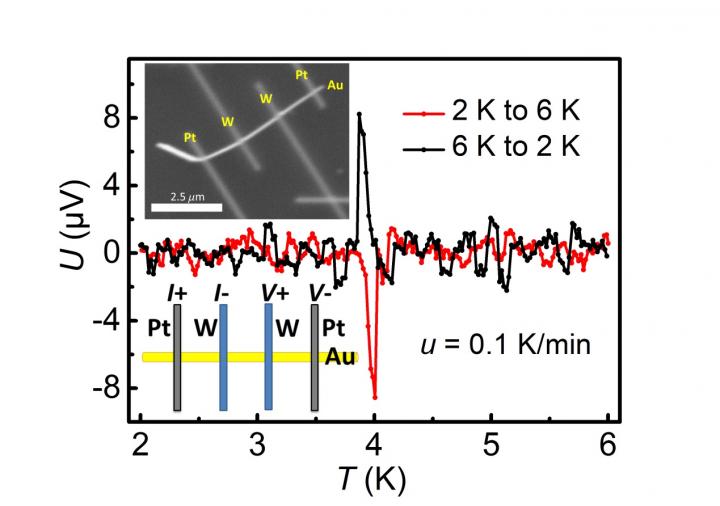
Non-local transport measurements reveal a novel voltage peak at superconducting transition temperature in gold nanowire with superconducting W electrodes. The voltage peak appears when cooling the sample across Tc, while the peak turns into dip in the warming process. Upper inset, a scanning electron microscope image of Au nanowire contacted by two superconducting W compound electrodes in the middle and two normal Pt electrodes at the ends. Lower inset, configuration of electrodes. In fact, the detected peak is irrelevant to the current, and similar phenomena can be observed even in the absence of current. Credit: Science China Press
Superconductivity, known as a quantum state with zero resistance and perfect diamagnetism, has attracted great attention in physical science. Due to the quantum size effect, low dimensional superconducting systems can exhibit novel behaviors different from bulk situation. Particularly, the investigations on strong spin-orbit coupling or ferromagnetic nanowires with superconducting contacts have become a research highlight in connection with the exploration of topological superconductivity and topological quantum computation. Dr. Jian Wang and Prof. Moses Chan have made a series of progresses in inducing superconductivity in nanowires. For instance, they have realized the proximity induced superconductivity in spin-orbit coupling Au and ferromagnetic Co nanowires (Phys. Rev. Lett. 102, 247003 (2009); Nat. Phys. 6, 389 (2010)), which lay the foundation for further investigation on topological superconductivity. In addition, Dr. Jian Wang, Prof. Nitin Samarth, Prof. Moses Chan and other collaborators detected the superconductivity in a topological insulator nanostrip via the superconducting proximity effect (Phys. Rev. B 84, 165120 (2011)). In that work, the authors reported a zero bias conductance peak and vortex induced quantum oscillations, which may be the evidences for topological superconductivity.
Recently, Prof. Jian Wang at Peking University, in collaboration with Prof. QingFeng Sun at Peking University and Prof. Moses Chan at Penn State University, observed a novel voltage signal in the hybrid nanowire structure. Normally, for a superconductor-normal material junction, the voltage across the junction should be zero when the current is not applied. However, in Au nanowire contacted by superconducting W electrodes, a voltage peak appears at time scale of one minute when cooling the system across the proximity induced superconducting transition temperature (Tc), while the peak turns into dip in the warming process (see the Figure below). The formation of voltage peak is irrelevant to the applied current, and the peak amplitude is proportional to temperature scanning rate. These characteristics distinguish the observed voltage signal from earlier works. By using Ginzburg-Landau model, the rise of the peak can be understood as a result of the emergence of Cooper pairs with relatively lower free energy in the W electrode; meanwhile the diffusion of Cooper pairs and quasiparticles from the W electrode to the Au nanowire suppresses the rising of the voltage and results in a voltage drop. The observation of voltage peak may benefit from the nanoscale contact area in hybrid nanowire structure and relatively long diffusion time.
The detection of the voltage peak offers direct evidence that the free energy of a system would decrease after entering the superconducting state. Moreover, similar voltage signal was also detected in Pt nanostrip contacted by superconducting electrodes, demonstrating the universality of the effect. Since the voltage signal appears at Tc and the applied current is not necessary, our finding offers a new way to detect superconductivity in nanostructures without current induced damage or dissipation.
This work has been recently published in Science China-Physics, Mechanics & Astronomy (2018) with the title of “Novel voltage signal at proximity-induced superconducting transition temperature in gold nanowires”. Prof. Jian Wang at Peking University and Prof. Moses Chan at Penn State University are corresponding authors of this paper.




